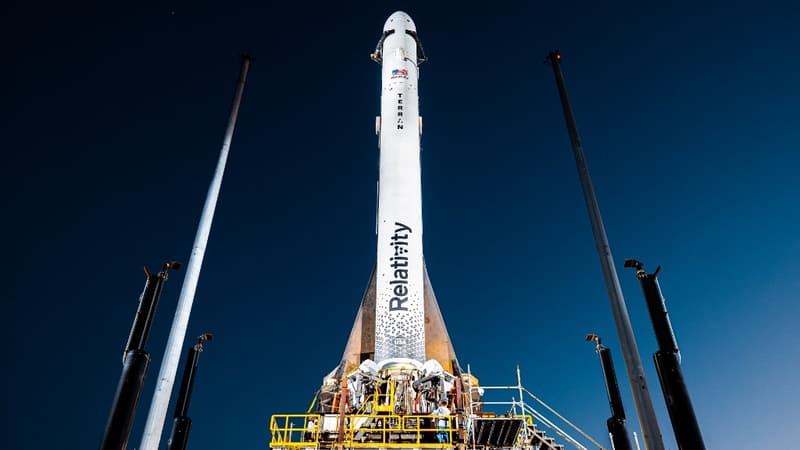Will the third attempt be the correct one? The first 3D-printed rocket will attempt its maiden flight again on Wednesday, after two previous tests were canceled at the last minute due to technical problems.
This mission, called “Good luck, have fun” (“Good luck, have fun,” in French), is highly scrutinized because 3D-printed rockets could represent a small revolution in the launch industry.
done in 60 days
California-based Relativity Space’s Terran 1 rocket will blast off from Cape Canaveral, Florida. The trigger window opens at 22:00 local time (2:00 GMT on Thursday) and closes three hours later.
A total of 85% of the rocket’s mass was 3D printed, and the company is targeting 95% in the future. Main advantage of the technique: it greatly simplifies the manufacturing process and thereby reduces costs.
With its large 3D printing robots, the company claims to divide the number of parts by 100 compared to a traditional rocket. The speed of the method also stands out: 60 days, from the raw material to the finished product.
Terran 1 measures 33.5 meters in height and just over 2 meters in diameter. Its first stage features nine engines, also 3D printed. It will need to be able to put 1250kg into low earth orbit (small satellites for example) making it a light launcher. But this first flight contains no payload.
Objective: Reach Earth orbit in 8 minutes
The rocket must reach, 80 seconds after takeoff, the point where the aerodynamic force exerted on the machine is maximum (max Q, in the jargon). This is the crucial stage of the flight, according to the young head of Relativity Space.
“We have already tested on the ground what we hope to test in flight: that when the dynamic pressure and stress on the vehicle are at their highest, 3D printed structures can withstand those forces,” Tim Ellis tweeted in early March. .
After the separation of the first stage of the rocket, the second must continue its journey until reaching Earth orbit, 8 minutes after takeoff. Achieving this step on the first flight would be “unprecedented,” according to Tim Ellis. In fact, the rocket uses metalox as fuel, a mixture of liquid oxygen and liquefied natural gas (essentially methane). If it manages to reach orbit, it would be the first rocket using this fuel to do so.
Two previous launch attempts
Relativity Space, which promotes the long-term view of humanity living on multiple planets, argues that it is the fuel “of the future,” the easiest to produce on Mars. The United Launch Alliance’s (ULA) Vulcan and SpaceX’s Starship rockets under development must also use this fuel.
A first attempt to launch the Terran 1 was abandoned on 8 March due to a fuel temperature problem. Then, on March 11, the takeoff was canceled twice in the final seconds of the countdown, first because of an automation problem, then because of a fuel pressure problem.
Whatever the degree of success of Terran 1’s maiden flight, the data collected will also be used to develop its big brother: the Terran R. This larger rocket, also developed by Relativity Space, should be capable of carrying 20,000 kg a low orbit.
The company has already signed contracts worth $1.65 billion, the majority for Terran R, according to Tim Ellis. One of them happened with the company OneWeb, whose constellation of satellites must provide internet from space.
Various startups around the rocket business
This type of rocket “medium-heavy is clearly where the most important market opportunity is for the rest of the decade, with a huge shortage currently in this payload class,” Tim Ellis tweeted.
A satellite operator can wait years before getting a place on the big Arianespace or SpaceX rockets.
Therefore, dozens of new companies have launched in recent years to meet the booming demand.
The number of satellites launched has gone from about 120 in 2012 to more than 2,700 in 2022, according to the specialized company Euroconsult.
Source: BFM TV


